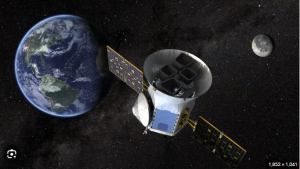ForumIAS announcing GS Foundation Program for UPSC CSE 2025-26 from 27th May. Click Here for more information.
Source-This post on Transiting Exoplanet Survey Satellite (TESS) is based on the article “Astronomers Find Super-Earth Exoplanet in Habitable Zone of TOI-715” published in “Science news” on 5th February 2024.
Why in the News?
Recently, astronomers utilized data from NASA’s Transiting Exoplanet Survey Satellite (TESS) to uncover and analyze a potentially habitable zone planet known as TOI-715b.
What is Transiting Exoplanet Survey Satellite (TESS)?

| Aspect | Details |
| About | 1. It is a NASA mission dedicated to locating planets that orbit the brightest stars visible from Earth. 2. It is a successor to NASA’s Kepler space telescope, which discovered thousands of exoplanets over a decade following its launch in 2009. |
| Launched on | April 18, 2018, using a SpaceX Falcon 9 rocket from Cape Canaveral(USA). |
| Mission life | The main mission concluded on July 4, 2020, and TESS is currently in an extended mission phase. |
| Orbit | 1. TESS follows a distinctive high Earth orbit, completing its cycle every 12 to 15 days. 2. This orbit is strategically inclined to minimize obstructions from Earth and the Moon, allowing the telescope an unimpeded view of the sky. |
| Significance | 1. During its two-year primary mission, TESS’s four cameras scanned more than 200,000 nearby and bright stars, covering 75% of the sky. 2. TESS discovers planets of various sizes and compositions, from small rocky ones to giant ones, demonstrating the galaxy’s planet diversity. |
How does TESS detect exoplanets?
1. It employs the transit technique to identify planets.
2. It searches for regular dips in the brightness of stars as planets pass in front of them from our perspective.
3. The bigger the planet, the greater the drop in brightness during the transit.
4. The duration it takes for a planet to transit in front of the star and return helps determine the shape of its orbit.
5. This method unveils the planet’s diameter and the size of its orbit.
UPSC Syllabus- Science & Technology




